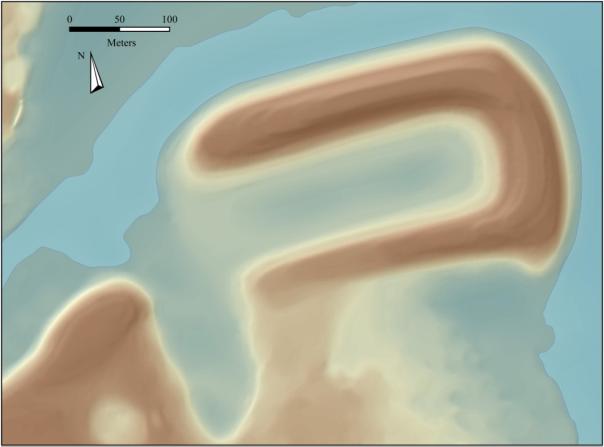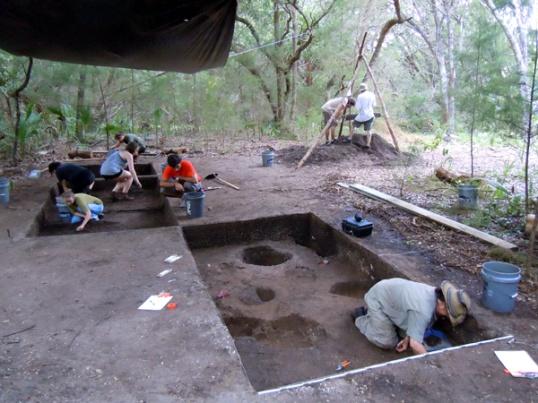July 2 – August 10, 2018
A nine-credit field practicum in all aspects of archaeological field work, including reconnaissance survey, site mapping and testing, and stratigraphic excavation. Evening laboratory sessions and lectures provide additional training in analysis, research design, and regional archaeology.
 The St. Johns River valley of northeast Florida was home to prehistoric hunter-gatherers for over 11,000 years. Some 8,500 years ago, certain groups began to harvest the rich shellfish resources of the river and mound the inedible remains in locations of repeated occupation. Most of these shell mounds were mined for road fill long ago, but many still preserve information of scientific value. Research currently focuses on the circumstances surrounding the formation of these mounds. Because they consist of the remains of species eaten by humans, shell mounds have tended to be interpreted as simply refuse heaps. Field school research is designed to test the idea that many of these mounds were constructed for ritual purposes.
The St. Johns River valley of northeast Florida was home to prehistoric hunter-gatherers for over 11,000 years. Some 8,500 years ago, certain groups began to harvest the rich shellfish resources of the river and mound the inedible remains in locations of repeated occupation. Most of these shell mounds were mined for road fill long ago, but many still preserve information of scientific value. Research currently focuses on the circumstances surrounding the formation of these mounds. Because they consist of the remains of species eaten by humans, shell mounds have tended to be interpreted as simply refuse heaps. Field school research is designed to test the idea that many of these mounds were constructed for ritual purposes.
The 2018 field school will return to the western shore of Lake George for the eighth year. In the 19th century, Jeffries Wyman described the shell deposits at the mouth of Silver Glen Run, which drains into Lake George, as the largest in all of northeast Florida. The U-shaped outline in the diagram to the upper left shows the extent of the deposits Wyman observed in 1871. Although this massive deposit was mined for shell in 1923, portions of its basal deposits remain intact below the present-day surface. To the west of this deposit is an area of some 20 hectares with the remnants of a 7,000-year-old shell ridge, at least two villages, and a sand burial mound. This year we will concentrate our efforts on the assemblage of pit features and associated midden that dates to the first intensive use of the site, plus we will conduct survey and testing at another shell-bearing sites at the mouth of Little Juniper Creek.
 Accommodations for field school are provided courtesy of our host organization for the five-week field session (July 9 – August 10). Beyond the fee for nine undergraduate credit hours, students will pay their share of communal subsistence and equipment costs (estimated at about $450). One additional week of lab orientation in Gainesville (July 2-6) is mandatory.
Accommodations for field school are provided courtesy of our host organization for the five-week field session (July 9 – August 10). Beyond the fee for nine undergraduate credit hours, students will pay their share of communal subsistence and equipment costs (estimated at about $450). One additional week of lab orientation in Gainesville (July 2-6) is mandatory.
The St. Johns Archaeological Field School is directed by Dr. Kenneth Sassaman in partnership with the University of Oklahoma field school directed by Dr. Asa Randall. Graduate students of Drs. Sassaman and Randall help to instruct and supervise field school students.
Contact Dr. Sassaman (sassaman@ufl.edu) for an application form. Due date for applications is March 30, 2018. Students are notified about admission decisions by April 16, 2018.
A summary of the 2016 St. Johns Archaeological Field School can be found here.
A summary of the 2012 St. Johns Archaeological Field School can be found here.
A summary of the 2010 St. Johns Archaeological Field School can be found here.
Reports
See the reports posted below for results of prior field schools:
- Sassaman, Kenneth E., Zackary I. Gilmore, and Asa R. Randall
2011. St. Johns Archaeological Field School 2007-10: Silver Glen Run (8LA1). Technical Report 12. Laboratory of Southeastern Archaeology, Department of Anthropology, University of Florida. Individual chapters can be downloaded here. - Randall, Asa R.
2007 St. Johns Archaeological Field School 2005: Hontoon Island State Park. Technical Report 7. Laboratory of Southeastern Archaeology, Department of Anthropology, University of Florida. - Randall, Asa R. and Kenneth E. Sassaman
2005 St. Johns Archaeological Field School 2003-2004: Hontoon Island State Park. Technical Report 6. Laboratory of Southeastern Archaeology, Department of Anthropology, University of Florida, Gainesville. - Sassaman, Kenneth E.
2003 St. Johns Archaeological Field School 2000-2001: Blue Spring and Hontoon Island State Parks. Technical Report 4. Laboratory of Southeastern Archaeology, Department of Anthropology, University of Florida, Gainesville.